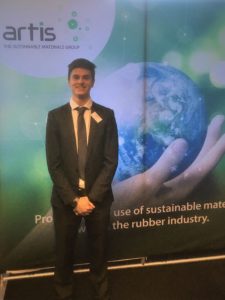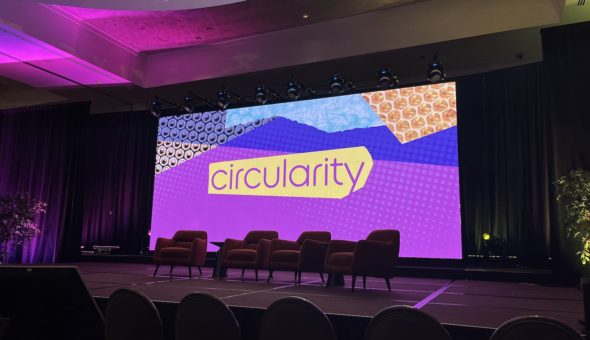Jamie is a first year PhD student working with Professor Matthew Davidson and ARTIS on the application of self-healing for rubber seals in the oil and gas industry.
My industrial partner, ARTIS, runs the annual Sustainable Materials Group (SMG) meeting. This is a chance for members of the group to come together to present new technologies and discuss sustainable developments in the rubber industry. At this year’s SMG meeting, I had the opportunity to present results from my project so far and network with key players in the rubber industry.
Whilst much of the meeting focussed on specific topics of interest, such as a significant discussion on improvements in recycled carbon black – a key research area for many of the group, the day started with presentations focusing on the topic of sustainability and challenges facing industry as a whole. I’ve chosen to highlight three talks which I felt had interesting take home points about the relationship between sustainability and industry.
Richard McKinlay (AXION) started out with some unpleasant realities of plastic recycling: currently in the UK, we don’t have the infrastructure to recycle all of our recyclable materials. This is partly due to the large variability in packaging types confusing both the consumer and recycling efforts. Statistics* for plastic recycling at the moment show that we are recycling 45.7 % of household waste and 70 % of packaging waste. However, if we include the statistics for our plastic which is sent to South Asian countries, then we only really deal with approximately 15 % of our waste. Although positive steps are being taken, including phasing out some problematic packaging types, there is still a long way to go.
Louis Brimacombe (IOM3) discussed the interplay of social demands, economic drivers and policy changes when using sustainability to make decisions, and the merits of thinking holistically; choice of materials and product design can have knock-on decisions throughout a product’s life. We should be careful to choose the material that is most sustainable over its lifetime rather than just one key section. For example, galvanised steel requires a more energy intensive end-of-life treatment, due to the processing required for the separation of zinc and steel, but it lasts 30 times longer than ungalvanised steel so it is usually a more sustainable choice of material. This was an interesting talk on the importance of understanding the overall process, and how considering social and environmental aspects as well as the traditional economic drivers can lead to better designs.
Tim Mitchell (Milkrite) spoke about Milkrite’s actions for sustainability. These actions included setting up conversations with their farmers about collection and replacement of their products. They produce milking equipment for the dairy industry and the rubber liners which are part of this equipment must be replaced after 20,000 milking events. By implementing a collection process, the waste of nearly 15 million rubber liners a year could be prevented. This gives Milkrite the opportunity to repair the liners or recycle them into other products. It was good to see a company recognising its environmental impact and working with its customers to improve process sustainability.

I really enjoyed the day, it was a good opportunity to understand the focus of the rubber industry and meet some of the key players in the rubber consulting business. I also gained valuable experience in presenting to a different audience and sparked some new ideas for my future work through networking.
Respond


